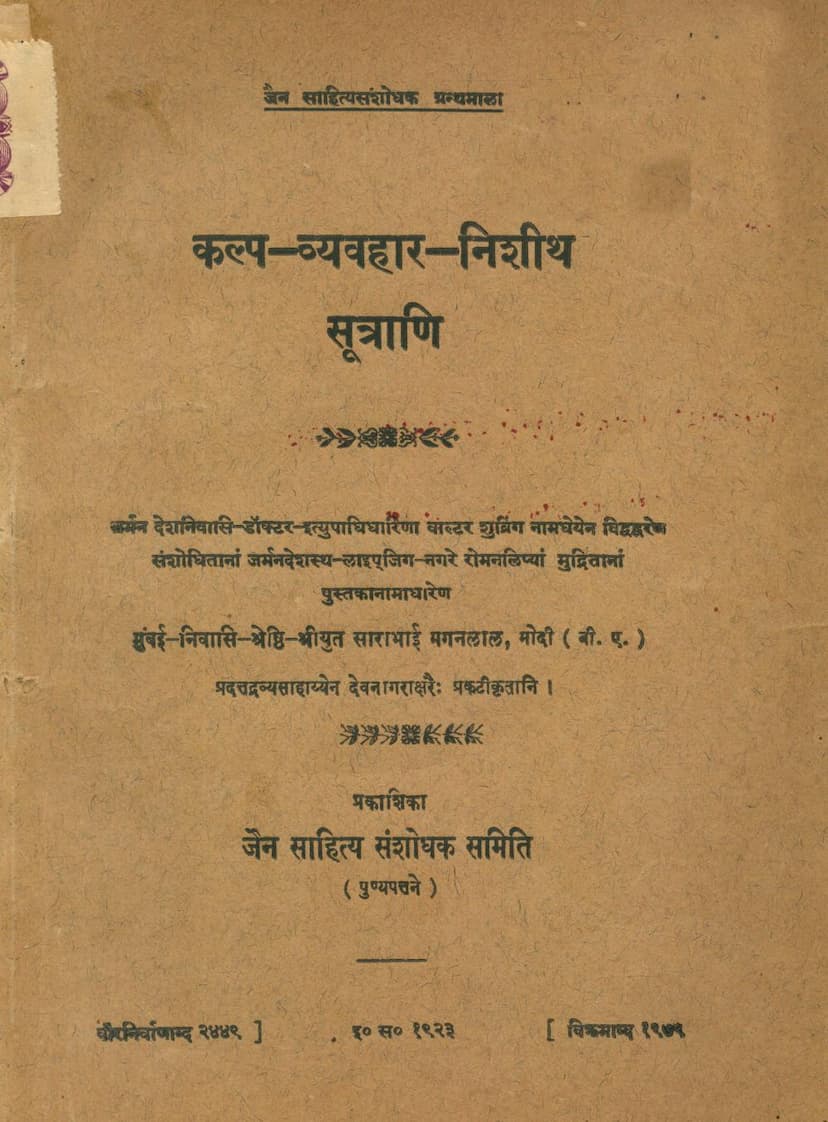Kalp Vyavahar Nisheeth Mul Matra
Added to library: September 2, 2025

Summary
This document appears to be a Jain religious text titled "Kalp Vyavahar Nisheeth Mul Matra," authored by Jinvijay. The provided text contains several chapters or sections, indicated by "उद्देसओ" (Uddesao), which are numbered sequentially. The text is written in Prakrit, the ancient language of Jain scriptures.
Key Themes and Content:
The text primarily deals with the conduct and rules (Kalp and Vyavahar) to be followed by Jain monks (Nigrantha) and nuns (Nigranthi). The "Nisheeth" aspect likely refers to prohibitions or strict observances. The content can be broadly categorized as follows:
- Dietary and Material Restrictions: Numerous verses detail what monks and nuns can and cannot eat, drink, or use. This includes rules about food preparation, acceptance of alms, the use of vessels, and the types of clothing or bedding allowed. For instance, there are specific guidelines on accepting food from houses, the conditions for using certain items, and prohibitions against using specific types of materials.
- Behavioral and Conduct Rules: The text outlines acceptable and prohibited actions for ascetics. This covers rules related to movement, dwelling places, interactions with the laity and other ascetics, and even specific activities like studying, meditating, or performing rituals. There are explicit mentions of what is permissible in different seasons or locations.
- Disciplinary Actions and Penances: The text discusses the consequences of breaking these rules, including terms of penance or purification (e.g., "chātumāsyika parihārāsthāna"). It also outlines the procedures for confession and repentance.
- Roles and Responsibilities: Certain verses differentiate between the conduct expected of monks and nuns, and sometimes specify rules for those in leadership positions (e.g., teachers, leaders of monastic groups).
- Specific Prohibitions and Permissions: The text frequently uses the phrasing "No kappai" (not permissible) and "Kappai" (permissible) to delineate rules. Examples include prohibitions against certain types of speech, actions during specific times of the day or night, and in particular locations.
- Concept of "Kappai" and "No Kappai": The central theme revolves around understanding what is acceptable ("kappai") and what is not ("no kappai") within the strict framework of Jain asceticism. This likely relates to purity, non-violence (ahimsa), and detachment.
- Specific Terms: The text uses specialized Jain terminology related to monastic life, such as "nigrantha" (monk), "nigranthi" (nun), "upasraya" (monastery/dwelling place), "bhikshacharya" (alms-seeking), "āchārya" (teacher), "upādhyāya" (preceptor), "parihāra" (penance), "ālochanā" (confession), and various types of food and clothing.
- Detailed Lists and Enumerations: The text often presents lists of prohibited items, actions, or conditions, making it a prescriptive guide for ascetic practice.
Context and Purpose:
The book is a foundational text for Jain ascetics, providing a detailed code of conduct essential for their spiritual discipline and adherence to Jain principles. The "Mul Matra" in the title suggests it might be a core or foundational text for understanding the rules of conduct. The mention of "Jain Education International" indicates its relevance for scholarly and personal study within the Jain tradition. The publication date (1923) suggests it's a scholarly edition of an ancient text.
In essence, "Kalp Vyavahar Nisheeth Mul Matra" serves as a comprehensive manual detailing the strict ethical, behavioral, and practical guidelines that Jain monks and nuns must follow to live a life of austerity, detachment, and spiritual purity. It emphasizes a meticulous approach to every aspect of their lives to uphold the principles of Jainism.